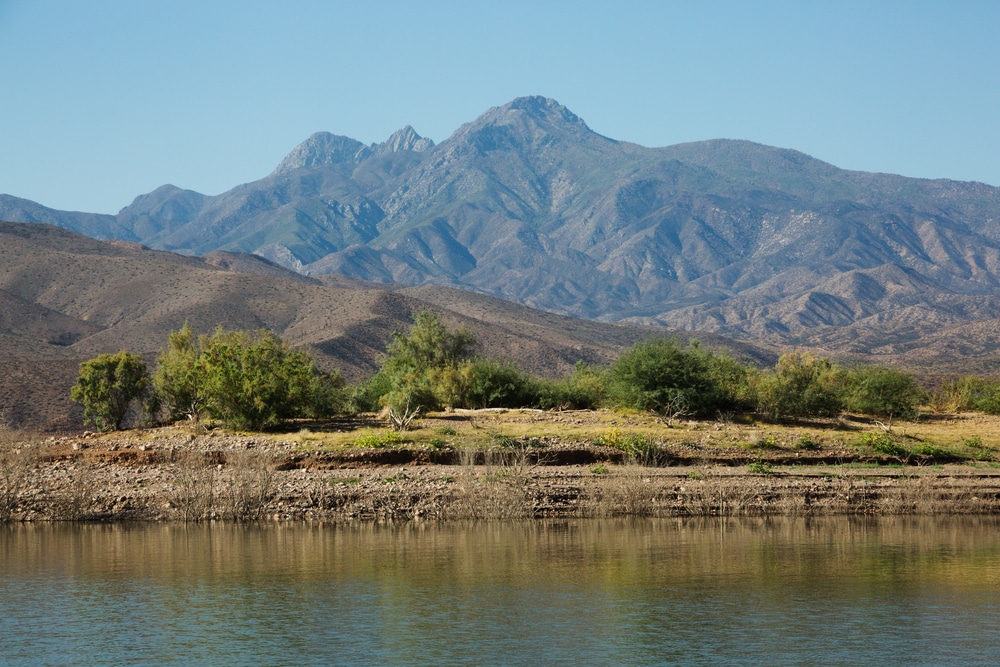Nestled in the rugged Sonoran Desert landscape, Theodore Roosevelt Lake emerges as a shimmering oasis amid the arid terrain of central Arizona. This expansive body of water stretches across the Tonto Basin, creating a stark and beautiful contrast against the surrounding saguaro-studded hills and distant mountain ranges. Located approximately 80 miles (130 km) northeast of Phoenix and 30 miles northwest of Globe, Roosevelt Lake stands as Arizona’s largest lake entirely contained within state borders, offering a welcome respite from the desert heat and a gateway to outdoor adventure.
Theodore Roosevelt Lake’s existence is intrinsically tied to Arizona’s complex relationship with water management. Created in 1911 with the completion of the iconic Roosevelt Dam on the Salt River, the lake was born from necessity—a solution to the erratic cycles of drought and flooding that plagued early settlers attempting to farm the arid region. What began as a critical water storage project has evolved into a multifaceted resource, serving as both a vital component of central Arizona’s water supply system and a premier recreational destination.

The lake is accessible via several routes, with State Highway 188 serving as the main artery that follows much of the southwestern shoreline. Visitors from Phoenix can take State Highway 87 (Beeline Highway) north for about 60 miles to the junction with Highway 188, then follow it southeast for approximately 26 miles to reach the lake. Those coming from Globe can take Highway 188 northwest for about 27 miles to access the lake’s eastern shore.
GPS coordinates for Roosevelt Dam: 33.6697° N, 111.1597° W
The creation of Roosevelt Lake marked a turning point in Arizona’s development. As the cornerstone of the Salt River Project (SRP), the dam and resulting reservoir transformed the desert into viable agricultural land, literally bringing life to the Valley and laying the foundation for the Phoenix metropolitan area to flourish. Today, Roosevelt Lake continues this legacy as a critical component of a water management system that delivers more than half of the Phoenix area’s annual water supply.

The historic Theodore Roosevelt Dam, completed in 1911 as the world’s tallest masonry dam, stands as an impressive engineering achievement. The visitor center offers exhibits detailing the dam’s construction and its vital role in water management and power generation for central Arizona. Informative displays explain the transformation of the Salt River Valley through this pivotal reclamation project.

The expansive waters of Roosevelt Lake provide ample space for all types of boating activities. The lake’s open areas are perfect for water skiing, wakeboarding, and jet skiing, while quieter coves offer peaceful paddling for kayakers and canoeists. Multiple boat ramps around the lake provide easy access, with marina services available at Roosevelt Lake Marina offering boat rentals, supplies, and fuel.

Theodore Roosevelt Lake is considered one of Arizona’s premier fishing destinations, spanning 22,000 acres when full. The lake hosts abundant populations of largemouth bass, smallmouth bass, crappie, channel catfish, and flathead catfish. Bass fishing tournaments are frequently held here, with the lake producing record-setting catches. The numerous coves, submerged trees, and varying depths create ideal fishing habitats, with the Tonto Creek and Salt River inlets being particularly productive areas.

The Tonto National Forest surrounding Roosevelt Lake maintains an extensive network of hiking trails. The Vineyard Trail offers spectacular lake views, while the more challenging Whiskey Springs Trail climbs to panoramic vistas of the entire lake basin. These paths showcase the transition zone between Sonoran Desert and higher elevation pine forests, creating diverse ecosystems to explore.

The area surrounding Roosevelt Lake contains significant archaeological treasures, including Tonto National Monument. This protected site features well-preserved cliff dwellings built by the Salado people in the 13th century. The Lower Cliff Dwelling is accessible via a moderate hike, while the Upper Cliff Dwelling can be visited through ranger-guided tours, offering insights into the ancient cultures that thrived in this region.

The lake and surrounding areas provide habitat for diverse wildlife including bald eagles, ospreys, great blue herons, desert bighorn sheep, and mule deer. The Tonto Creek inlet is particularly known for bird watching opportunities, while the shoreline at dawn and dusk offers the best chances to observe mammals coming to drink. The Roosevelt Lake Wildlife Area is specifically managed to protect critical habitat.

Roosevelt Lake features numerous developed campgrounds and dispersed camping areas. The Cholla, Windy Hill, and Schoolhouse campgrounds offer amenities including restrooms, showers, and RV hookups. For those seeking a more primitive experience, shoreline camping is permitted in designated areas, allowing visitors to establish campsites with direct lake access and stunning views of the surrounding mountains.

Multiple day-use areas around Roosevelt Lake provide amenities for picnicking and relaxation. Cholla Recreation Area and Windy Hill Recreation Area feature covered ramadas, grills, restrooms, and shoreline access. These developed sites offer comfortable spaces to enjoy lakeside meals with spectacular views of the Sierra Ancha Mountains and Superstition Mountains.
Theodore Roosevelt Lake has earned its reputation as one of Arizona’s premier fishing destinations, attracting anglers from across the state and beyond. The lake supports a diverse population of game fish, making it a year-round angler’s paradise with opportunities for both novice and experienced fishing enthusiasts.
The most sought-after species in Roosevelt Lake include:
Prime fishing locations vary with seasons and water levels. The Salt River and Tonto Creek inflow areas are particularly productive during spring runoff. The many coves along the shoreline provide excellent habitat, especially when water levels rise and flood brush and trees. Rock piles, submerged points, and drop-offs near the old river channel are consistently productive spots.
Seasonal patterns significantly impact fishing success at Roosevelt Lake. Spring (March through May) is generally considered prime fishing season when bass move into shallow water to spawn. Summer fishing can be excellent during early morning and evening hours, while the deep water channels become more productive during midday heat. Fall brings another period of active feeding as fish prepare for winter. Winter fishing slows but can be productive on sunny days when fish move to shallow, sun-warmed water.
All anglers must possess a valid Arizona fishing license, available online through the Arizona Game and Fish Department or at various retail outlets. Special regulations may apply to certain species, including size and bag limits. The bass fishery has occasionally been managed with slot limits (requiring release of bass within certain size ranges) to protect spawning-size fish and maintain healthy populations.
Professional fishing guides are available for hire through the Roosevelt Lake Marina and independent operators, offering visitors expert guidance to productive fishing spots and techniques. The lake hosts numerous fishing tournaments throughout the year, from small local competitions to major bass tournaments that attract anglers from across the region.
The expansive waters of Roosevelt Lake provide ideal conditions for various boating activities, from peaceful paddling excursions to exhilarating powerboat adventures. With over 21,500 acres of water surface when full, the lake offers ample space for all types of watercraft to operate safely and enjoyably.
Roosevelt Lake welcomes both motorized and non-motorized watercraft. While there are no horsepower restrictions on most of the lake, several designated no-wake zones exist, particularly around marinas, swimming areas, and sensitive wildlife habitats. These areas are clearly marked with buoys. The Tonto Creek arm of the lake is closed to all watercraft from November 5 to February 15 to protect wildlife.
The lake features multiple boat launch facilities strategically located around its perimeter:
Most launch ramps include parking areas, restrooms, and some provide fish cleaning stations. During periods of low water, some ramps may become unusable – visitors should check current conditions before planning their trip.
Roosevelt Lake presents few significant navigation hazards, though submerged trees, rock formations, and sandbars can appear during lower water levels. The Salome Cove channel is marked by buoys indicating one-way traffic lanes for safety. Wind conditions can change rapidly, occasionally creating choppy waters, particularly in the afternoon. Boaters should always monitor weather forecasts and be prepared for changing conditions.
Roosevelt Lake Marina offers various rental options for visitors without their own watercraft:
The marina also provides boat storage services, both wet slips and dry storage, for regular visitors to the lake. Additional services include:
The lake’s boat traffic varies significantly by season and day of the week. Summer weekends and holidays see the heaviest use, particularly in the main basin near the dam and marina. Weekdays and non-summer seasons offer more tranquil boating experiences. The lake’s numerous coves and inlets provide opportunities to escape the busier areas, especially for paddlers and those seeking quieter fishing spots.
Theodore Roosevelt Lake’s warm waters and extensive shoreline create ideal conditions for swimming and various water sports throughout much of the year. The lake’s desert setting ensures pleasant water temperatures from spring through fall, making it a refreshing escape from Arizona’s heat.
While Roosevelt Lake doesn’t have officially designated swimming beaches with lifeguards, several areas are popular for swimming due to their gradual entry points and sandy or pebbly shorelines. Some of the more frequented swimming locations include:
Visitors should note that no lifeguards are on duty anywhere on the lake, and swimming is always at one’s own risk. Water quality is generally good, though algae blooms can occasionally occur during hot summer months. The Arizona Department of Environmental Quality monitors water quality, and any advisories are posted at recreation sites and online.
Beyond swimming, Roosevelt Lake supports a wide variety of water sports:
Designated areas exist to separate potentially conflicting water activities. No-wake zones are enforced near shorelines, marinas, and swimming areas. During busy summer weekends, the main basin can become crowded with various watercraft, while the lake’s arms and coves typically offer more separated spaces for different activities.
Equipment rentals are available through Roosevelt Lake Marina, including:
Safety considerations are paramount for all water activities at Roosevelt Lake. Arizona law requires life jackets for children 12 and under while on the water, and all vessels must carry appropriate safety equipment. The lake’s water level can fluctuate significantly throughout the year, potentially creating submerged hazards as levels drop. The desert environment also presents risks of dehydration and sunburn – proper hydration, sunscreen, and protective clothing are essential for safe enjoyment of the lake’s recreational opportunities.

| Category | Details |
|---|---|
| Location | Central Arizona, USA (75 miles northeast of Phoenix) |
| Formation | Created by Roosevelt Dam, completed in 1911 |
| Dam Modification | Major reconstruction/modification completed in 1996 |
| Surface Area | Approximately 21,500 acres (87 km²) when full |
| Length | About 22.4 miles (36 km) |
| Shoreline | Approximately 128 miles (206 km) |
| Maximum Capacity | 1.6 million acre-feet (2 km³) |
| Dam Type | Originally masonry arch, modified to concrete arch dam |
| Original Dam Height | 280 feet (85 m) |
| Current Dam Height | 357 feet (109 m) after modification |
| Dam Length | 1,210 feet (369 m) at crest |
| Water Sources | Salt River and Tonto Creek |
| Purpose | Water storage, flood control, hydroelectric power, recreation |
| Hydroelectric Capacity | 36 megawatts |
| Named After | President Theodore Roosevelt, who dedicated the dam in 1911 |
| Management | Tonto National Forest (U.S. Forest Service) |
| Recreation | Fishing, boating, camping, water sports, hiking |
| Notable Fish Species | Largemouth bass, smallmouth bass, crappie, catfish, carp |
| Historical Significance | First major project under the Federal Reclamation Act of 1902 |
| Part Of | Salt River Project (SRP) water system |
| Nearby Features | Tonto National Monument, Apache Trail |
| Wildlife | Bald eagles, herons, various desert species |
| Distinction | Largest lake entirely within Arizona |
Theodore Roosevelt Lake stands as an impressive aquatic feature in Arizona’s arid landscape, covering approximately 21,500 acres at full capacity. This makes it the largest lake located entirely within Arizona’s borders, surpassed in size only by Lake Mead and Lake Powell, which extend into neighboring states. The lake boasts an extensive shoreline measuring approximately 128 miles, exceeding the 116-mile driving distance between Phoenix and Tucson.
The reservoir stretches approximately 22 miles along the original course of the Salt River and extends about 8 miles up Tonto Creek, one of the Salt River’s significant tributaries. The lake’s distinctive shape follows the natural contours of the Tonto Basin, creating numerous coves and inlets that provide secluded areas for recreation and wildlife habitat.
At maximum capacity, Roosevelt Lake holds an impressive 1.6 million acre-feet of water (enough to cover 1.6 million acres with one foot of water), making it the largest storage reservoir in the Salt River Project system. The lake’s depth varies considerably, reaching its deepest point near the dam. Water levels fluctuate seasonally and yearly based on precipitation, runoff patterns, and water management needs downstream.
Roosevelt Lake sits at an elevation of approximately 2,100 feet above sea level, placing it in a transition zone between the lower Sonoran Desert and higher elevation ecosystems. This positioning creates a unique environment where desert vegetation like saguaro cacti, mesquite, and palo verde trees dominate the surrounding landscape.
The lake’s water source is primarily the Salt River, which originates in the White Mountains of eastern Arizona, supplemented by Tonto Creek flowing south from the Mogollon Rim. Both waterways can vary dramatically in flow, from nearly dry during drought conditions to raging torrents during monsoon seasons or winter storms. This variability underscores the lake’s crucial role in flood control and water storage.
Water quality in Roosevelt Lake is generally good, though clarity can vary with seasonal conditions and location. The lake typically displays a blue-green color, with water temperatures ranging from the 50s°F in winter to the 90s°F during the height of summer. These warm summer temperatures make it particularly attractive for water recreation during Arizona’s hot months.
The surrounding landscape reveals much about the area’s geological story. The lake sits in the Tonto Basin, flanked by multiple mountain ranges: the Sierra Ancha to the east, the Mazatzal Mountains (including Four Peaks) to the west, and the Superstition Mountains to the southwest. These mountains consist primarily of various volcanic rocks, with exposed granite, basalt, and schist formations creating dramatic vistas. The region’s geology has been shaped by millions of years of uplift, erosion, and volcanic activity, resulting in the rugged terrain that cradles Roosevelt Lake today.
Theodore Roosevelt Dam stands as a monumental achievement in American engineering and water management history. Completed in 1911, it was the first major structure constructed by the Bureau of Reclamation on the Salt River Project and represented a pivotal moment in Arizona’s development.
The dam’s construction was born of necessity. In the late 19th century, early Arizona settlers struggled with the region’s erratic water patterns—enduring devastating droughts punctuated by catastrophic floods. As early as 1889, territorial officials identified the confluence of the Salt River and Tonto Creek as an ideal location for a dam to regulate water flow. However, the ambitious project remained beyond reach until the passage of the National Reclamation Act in 1902, signed into law by President Theodore Roosevelt, which provided the necessary federal funding.
Construction began in 1903 at what was initially known as the “Tonto Site.” The original structure was a cyclopean, rubble-masonry, thick-arch dam that stood 280 feet high with a crest length of 723 feet. At completion, it contained 355,800 cubic yards of masonry and was the world’s largest masonry dam and created what was then the world’s largest artificial lake. This engineering marvel was dedicated by President Theodore Roosevelt himself on March 18, 1911. During the dedication ceremony, Roosevelt pressed a button to release water from the reservoir and remarked, “If there could be any monument which would appeal to any man, surely this is it.”
The dam underwent its first modifications in 1936 when the spillways were altered by lowering their crests by 6 feet to increase capacity and installing individual gate hoists and operating motors. However, the most significant transformation occurred between 1989 and 1996, when the Bureau of Reclamation undertook extensive safety modifications. This massive renovation encased the original rough-hewn stones in concrete, transforming the structure into a concrete-gravity arch dam. The project raised the dam’s height by 77 feet to its current 357 feet and extended its crest length to 1,210 feet. These modifications increased water conservation storage capacity by 20 percent and added crucial flood control space.
The renovation included the construction of two new spillways, installation of new outlet works, and powerplant modifications. The project cost approximately $430 million and used 849 miles of reinforcing steel. Unfortunately, these extensive modifications led to the dam losing its National Historic Landmark status in March 1999, as they permanently altered the “integrity of design, materials, workmanship, feeling, and association” of the original structure.
Today, Roosevelt Dam is managed by the Salt River Project (SRP) in cooperation with the Bureau of Reclamation. The dam serves multiple purposes:
The Bureau of Reclamation conducts annual spill gate tests to confirm operational readiness in case of flooding. As part of these tests, dam operators open the reservoir flood gates to release water downstream into Apache Lake, ensuring no water is wasted.
Public access to the dam itself is limited, but the Roosevelt Lake Bridge, completed in October 1990, provides a spectacular view of the structure. This $21.3 million bridge is noteworthy in its own right—it’s the longest two-lane, single-span, steel-arch bridge in North America, spanning 1,080 feet across Roosevelt Lake. The bridge was built to take traffic off the dam’s top, which was originally designed to allow two Model-T Fords to pass abreast but became inadequate for modern vehicles. In November 1995, the American Consulting Engineers Council named it one of the top 12 bridges in the nation, alongside such icons as the Golden Gate Bridge and Brooklyn Bridge.
Theodore Roosevelt Lake offers diverse camping options to suit every outdoor preference, from developed campgrounds with amenities to primitive shoreline camping for those seeking a more rustic experience. The lake’s expansive shoreline and surrounding Tonto National Forest provide numerous opportunities to spend the night under Arizona’s star-filled skies.
Several established campgrounds operated by the Tonto National Forest surround Roosevelt Lake:
The largest and most developed campground at Roosevelt Lake, located on a scenic mesa overlooking the water.
Located on the south shore with good water access.
Situated near the Salt River inlet on the eastern portion of the lake.
Located on the north shore with easy lake access.
Specifically designed for larger groups.
Roosevelt Lake is known for its abundant shoreline camping opportunities along its 128 miles of coastline. Popular areas for dispersed shoreline camping include:
Shoreline camping regulations:
For those seeking more comfortable accommodations near Roosevelt Lake:
The vegetation surrounding Roosevelt Lake exemplifies the transition between desert and riparian ecosystems:
Dominant plant communities include:
The hillsides surrounding the lake feature iconic Sonoran Desert vegetation including saguaro cacti, barrel cacti, prickly pear, cholla, mesquite, palo verde, and ocotillo. These plants have evolved specialized adaptations to conserve water and survive in the harsh desert environment.
Along the shoreline and inflowing streams, water-loving species create lush corridors. Cottonwood, willow, Arizona ash, and desert hackberry trees provide crucial shade and habitat. When lake levels recede, a “bathtub ring” of early successional plants like Bermuda grass, cocklebur, and various annual grasses and forbs quickly establish in the exposed areas.
Between the desert uplands and riparian zones, mixed vegetation communities include jojoba, catclaw acacia, desert broom, and various drought-tolerant shrubs and grasses.
Seasonal wildflower displays can be spectacular following wet winters, with Mexican gold poppies, lupines, globe mallows, and numerous other species creating vibrant carpets of color across the normally brown landscape.
The diverse habitats around Roosevelt Lake support abundant wildlife:
The best wildlife viewing locations around Roosevelt Lake include:
Dawn and dusk typically provide the best wildlife viewing times, when desert animals are most active. Winter months bring migratory waterfowl and bald eagles, making it an excellent season for bird watching. The monsoon season (July-September) triggers increased activity among reptiles and amphibians.
Several conservation initiatives protect Roosevelt Lake’s ecosystem:
Visitors can experience the natural environment through various trails and educational opportunities:
Spring represents one of the most popular and pleasant seasons at Roosevelt Lake:
Summer brings intense heat but remains popular for water recreation:
Fall brings milder temperatures and less crowded conditions:
Winter offers a quieter experience with unique recreational opportunities:
Roosevelt Lake’s levels can vary dramatically throughout the year, impacting recreation in significant ways:
Current lake levels can be checked through the Salt River Project website or by contacting the Tonto Basin Ranger Station before planning a visit.
Fire regulations at Roosevelt Lake vary seasonally based on conditions and fire danger levels:
Current fire restriction information is available from the Tonto National Forest website, ranger stations, and posted at recreation sites.
Several small communities surround Roosevelt Lake, offering services and local character:
The Roosevelt Lake area hosts several annual events that may enhance a visit:
For a successful visit to Roosevelt Lake, consider packing these essential items based on your planned activities:
The desert environment around Roosevelt Lake presents unique challenges:
Roosevelt Lake offers spectacular photographic opportunities:
Theodore Roosevelt Lake stands as a shimmering jewel in Arizona’s crown of natural treasures, a testament to human ingenuity harmonizing with nature’s grandeur. This magnificent body of water, cradled by saguaro-studded hills and distant mountain silhouettes, represents far more than a recreational oasis—it embodies Arizona’s complex relationship with water and the transformative power of visionary infrastructure.
The legacy of Roosevelt Dam extends far beyond its impressive physical dimensions. Without this pioneering structure and the lake it created, the Phoenix metropolitan area might never have blossomed into the thriving region it is today. The waters impounded here have nourished generations of Arizonans, turning desert into productive farmland and supporting the growth of communities across the Salt River Valley.
As visitors explore Roosevelt Lake’s expansive waters, camp along its scenic shorelines, or marvel at the engineering achievement of its historic dam, they participate in a continuing story of adaptation and resilience in an arid landscape. The lake represents humanity’s capacity to shape our environment while reminding us of our responsibility to preserve the natural systems that sustain us.
This precious resource requires careful stewardship. As climate patterns shift and population pressures increase, the challenge of balancing water storage, flood control, recreation, and wildlife habitat becomes increasingly complex. Each visitor has a role to play in protecting Roosevelt Lake’s waters and surrounding ecosystems for future generations—practicing conservation, respecting wildlife, and treading lightly on the landscape.
Whether you come to Roosevelt Lake seeking the thrill of landing a trophy bass, the tranquility of a desert sunset reflected on calm waters, or simply a respite from urban life, you’ll find something that resonates deeply with the Arizona spirit. This remarkable destination captures the essence of the American Southwest—rugged, resilient, and surprisingly rich with life and beauty.
As you depart Roosevelt Lake, carry with you not only memories of adventures enjoyed and landscapes admired but also a deeper appreciation for the vital role water plays in our desert home. In this place where human achievement and natural splendor converge, we find inspiration for meeting the challenges of our shared future with the same vision, determination, and respect for the land that created Theodore Roosevelt Lake over a century ago.